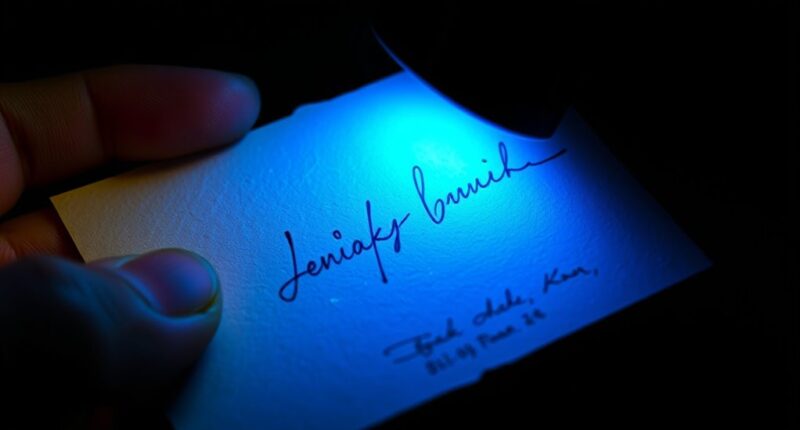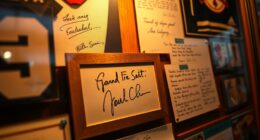Using UV light is a key trick every collector needs. It reveals hidden markings, security features, and inconsistencies in inks that can expose forgeries. Genuine autographs often show predictable fluorescence, while counterfeits may have irregular glow patterns or uneven ink reactions. By inspecting signatures under UV light and comparing fluorescence patterns, you can spot alterations or repairs. Continue exploring to learn more about how UV tricks can help you verify authenticity with confidence.
Key Takeaways
- Use UV light to detect inconsistent fluorescence patterns that may indicate forgery or tampering with the autograph.
- Look for hidden security marks or watermarks only visible under UV light to verify authenticity.
- Compare fluorescence brightness and uniformity to distinguish between genuine vintage inks and modern or fake inks.
- Spot irregular glow, streaks, or uneven fluorescence to identify added, erased, or altered signatures.
- Ensure proper preparation by cleaning the autograph and working in a dim environment for accurate UV fluorescence analysis.
Understanding How UV Light Reveals Authenticity Clues
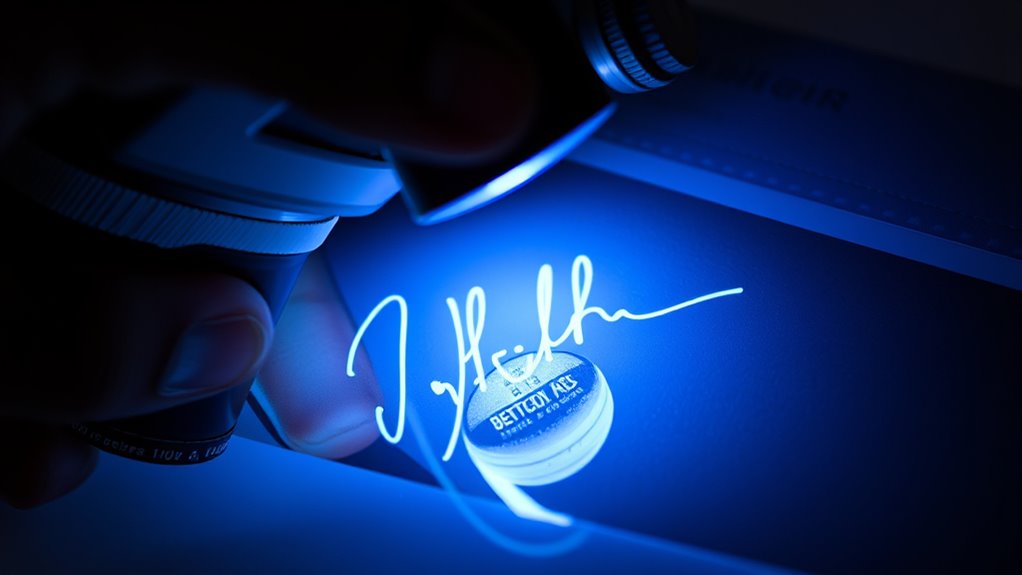
When you shine UV light on an autograph, it can reveal hidden clues that aren’t visible to the naked eye. UV light causes certain inks and materials to fluoresce, making features like signatures, stamps, or markings stand out. Genuine autographs often contain inks that react predictably under UV, showing consistent fluorescence or lack thereof. Forgeries might lack this reaction or display irregular glowing patterns due to different ink compositions. Additionally, some authentic signatures include invisible security marks or watermarks only visible under UV. By observing these reactions carefully, you can gather critical clues about an autograph’s authenticity. This process helps distinguish original signatures from counterfeit ones, offering a clearer picture of the item’s legitimacy before you consider further verification methods. Moreover, understanding AI security vulnerabilities can improve the development of better authentication tools that leverage UV technology for enhanced accuracy. Recognizing the varieties of inks used in signatures can further aid in identifying genuine autographs, as authentic signatures often use specific ink formulations that respond consistently under UV light. Being aware of lighting conditions is also essential, as certain lighting setups can enhance the visibility of fluorescence and improve detection accuracy. Knowing common counterfeit techniques can also help you identify signs of forgery, such as inconsistent fluorescence or unnatural ink patterns.
Recognizing Common Signs of Forgery Under UV Light

When examining an autograph under UV light, look for inconsistent fluorescence patterns that don’t match authentic signatures. Unusual ink reactions, such as unexpected glow or uneven fluorescence, can also indicate a forgery. Spotting these signs helps you identify potential fakes more confidently. Additionally, understanding ink reactions under UV light can provide further clues about authenticity. Variations in fluorescence may also be caused by different ink compositions used in forgeries versus genuine autographs, making it essential to familiarize yourself with these differences. Being aware of autograph aging and how it influences fluorescence can further improve your detection accuracy. Recognizing how ink longevity impacts UV reactions can also aid in authenticating signatures over time.
Inconsistent Fluorescence Patterns
Inconsistent fluorescence patterns under UV light are a common sign of forgery because genuine autographs typically display uniform or predictable fluorescence, while forgeries often show irregularities. When examining a signature, look for these telltale signs:
- Uneven or patchy glow that doesn’t match the expected ink or paper type.
- Sudden bright spots or dark areas indicating inconsistent ink application.
- Fluctuating fluorescence that varies across different parts of the autograph, suggesting multiple inks or alterations.
These irregular patterns can signal that the signature was altered or reproduced with inconsistent materials. Authentic autographs tend to fluoresce uniformly because the ink and paper are consistent throughout. Spotting these inconsistencies helps you identify potential forgeries quickly and accurately.
Unusual Ink Reactions
Unusual ink reactions under UV light are a strong indicator of forgery because authentic signatures typically contain ink that reacts consistently. If certain areas glow unevenly or show unexpected color shifts, it suggests tampering or the use of non-standard ink. Genuine ink often fluoresces uniformly, while fake signatures may display patchy or abnormal reactions. For example, here’s what you might see:
| Authentic Ink | Forged Ink |
|---|---|
| Consistent glow | Irregular patches |
| Bright, even fluorescence | Dull or variable fluorescence |
| No unexpected color shifts | Flickering or color changes |
| Smooth reaction | Spotty or streaky areas |
| Fluorescence matches ink type | Discrepancies with expected ink |
Spotting these signs helps you identify potential forgeries quickly and confidently.
Preparing Your Autograph and Equipment for UV Inspection
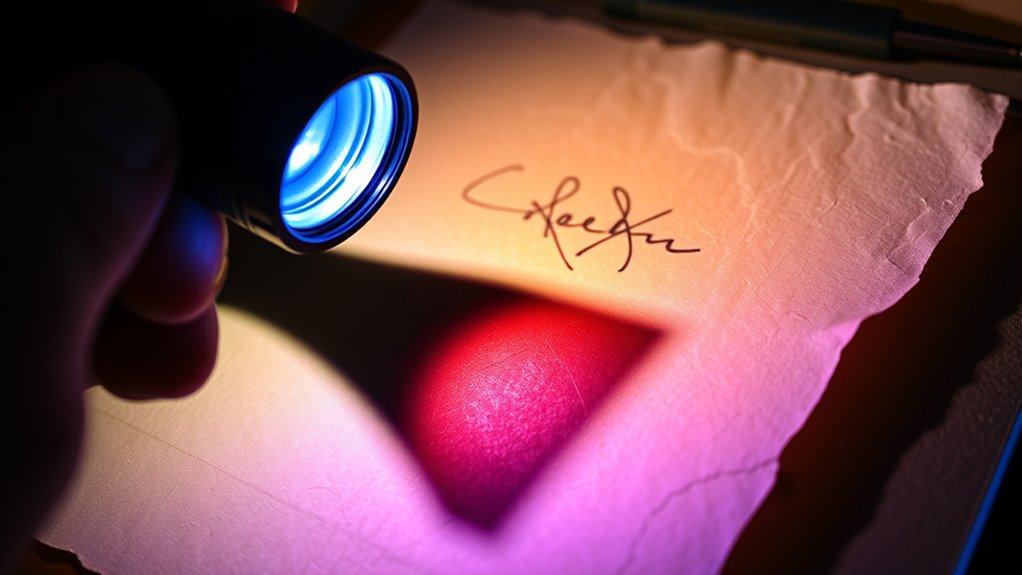
To guarantee accurate UV inspection of your autograph, start by carefully cleaning both the autograph and your equipment. Dust, oils, and fingerprints can interfere with fluorescence detection, so use a soft, lint-free cloth to wipe the surface gently. Next, ensure your UV light source is clean and functioning properly—check for any smudges or residues that could affect illumination. Finally, set up a controlled environment: dim the room lights, eliminate reflective surfaces, and position your autograph in a stable, well-lit spot. This preparation minimizes distractions and maximizes visibility of fluorescent markings. By following these steps, you’ll create ideal conditions for revealing hidden details and ensuring a precise, reliable UV inspection. Incorporating industry insights can further help you interpret fluorescence results accurately.
Interpreting Fluorescent Markings and Inks

When examining inks under UV light, you can spot hidden signatures or markings that aren’t visible to the naked eye. Analyzing these fluorescent features helps determine if an autograph has been altered or added later. Understanding ink composition also provides clues about the authenticity and age of the signature. Recognizing inspirational quotes and their significance can deepen the appreciation of the artistry involved in autographs. Additionally, UV light can reveal security features embedded in modern signatures or documents, aiding in verification. The presence of specific fluorescent inks can further confirm the period or origin of an autograph, making UV analysis an essential tool for collectors. Incorporating knowledge of AI in Education can also assist in developing advanced authentication tools that analyze UV fluorescence patterns with greater accuracy.
Detecting Hidden Signatures
Have you ever wondered how experts uncover hidden signatures that aren’t visible to the naked eye? UV light reveals fluorescent markings that indicate concealed signatures. To interpret these markings effectively, you should:
- Scan the entire autograph with a UV light, focusing on areas that seem suspicious or inconsistent.
- Identify fluorescent inks or pigments that glow under UV, which may hide authentic signatures or forgeries.
- Compare fluorescence patterns with known authentic examples to determine if the markings align with genuine signatures.
Analyzing Ink Composition
Once you’ve identified fluorescent markings under UV light, analyzing the ink composition becomes essential to distinguish authentic signatures from forgeries. Different inks react uniquely to UV light, revealing clues about their age and origin. You can compare the fluorescence pattern, brightness, and color to known authentic inks. Some forgeries use modern inks that fluoresce differently than vintage signatures. To help, consider this table:
| Ink Type | Fluorescence Pattern | Typical Use |
|---|---|---|
| Vintage Ink | Fades quickly, subtle glow | Historical documents |
| Modern Ink | Bright, consistent glow | Recent signatures |
| Forgery Ink | Uneven, unusual fluorescence | Fake signatures |
Additionally, understanding the spiritual energy associated with certain materials can aid in authenticating items, as genuine signatures often carry a subtle energetic signature that can be perceived through intuitive methods. Recognizing the ink composition can also provide insight into the signature’s authenticity, especially when combined with UV analysis and intuitive perception.
Spotting Alterations and Repairs With UV Light
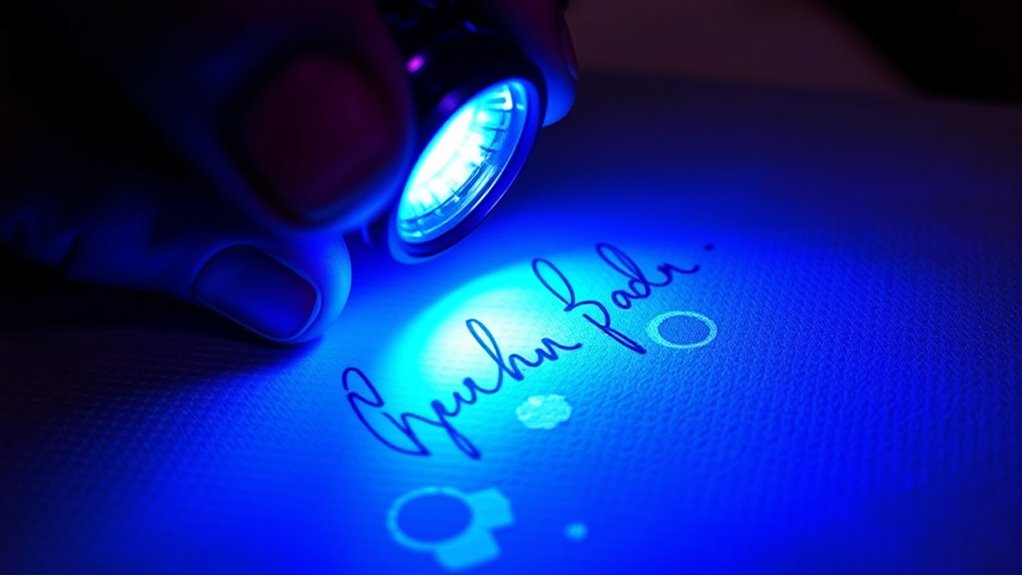
Using UV light is an effective method to detect alterations and repairs on autographs, as it reveals details invisible to the naked eye. When you shine UV light, look for areas that fluoresce differently than the surrounding ink, indicating possible tampering. Here are key signs to watch for:
Using UV light helps uncover hidden alterations and repairs on autographs.
- Uneven fluorescence – spots or streaks that glow differently could signal added or replaced ink.
- Inconsistent ink color – variations in fluorescence may suggest repairs or alterations.
- Hidden markings or corrections – UV light can reveal erased or covered-up writing not visible normally.
- Additionally, understanding proper autograph preservation techniques can help maintain the authenticity and condition of your collection. Proper storage methods are essential to prevent deterioration and ensure your autographs retain their value over time.
Combining UV Light Results With Other Authentication Methods

To accurately authenticate an autograph, it’s essential to combine UV light results with other verification methods, as relying on a single technique can be misleading. Use provenance records to trace the item’s history and confirm its origin. Compare the signature style with known authentic examples, paying attention to strokes, pressure, and consistency. Examine the ink’s age and type, ensuring it matches the period and materials used. Consider professional authentication services, which evaluate all aspects of the autograph, including paper quality and handwriting analysis. Incorporating the importance of comprehensive analysis ensures a thorough evaluation process. Combining UV light findings with these methods provides an inclusive assessment, reducing the risk of accepting forgeries. This multi-layered approach helps you confidently determine authenticity and avoid costly mistakes in your collection.
Frequently Asked Questions
Can UV Light Damage Delicate or Aging Autographs?
You might wonder if UV light can harm delicate or aging autographs. UV light doesn’t typically cause immediate damage like fading or deterioration if used carefully and sparingly. However, prolonged or intense exposure could weaken paper or ink over time. To protect your autographs, use UV light for short periods and keep it at a safe distance, ensuring you verify authenticity without risking long-term damage to your collection.
Are There Specific UV Light Types Better for Autograph Inspection?
You might think all UV lights are equal for inspecting autographs, but ironically, selecting the right type makes all the difference. LED UV lights are your best bet—they emit less heat and are safer for delicate, aging autographs. Avoid cheap, high-intensity bulbs that could damage your collectibles. Investing in a quality, adjustable LED UV light ensures you get clear, safe inspections without risking damage.
How Do I Differentiate Between Genuine Fluorescent Inks and Forgeries?
To tell genuine fluorescent inks from forgeries, you need to observe how the ink reacts under UV light. Genuine inks often glow consistently and evenly, while forgeries might show uneven or unusual fluorescence. Pay attention to color differences and how the ink appears in various lighting conditions. Remember, some forgeries attempt to mimic fluorescence, so combine UV inspection with other authentication methods for the best results.
Is UV Light Inspection Reliable for All Autograph Types?
You ask if UV light inspection is reliable for all autograph types. While UV light helps reveal forgeries by highlighting certain inks, it’s not foolproof for every autograph. Some forgers use inks that fluoresce naturally or mimic authentic signatures under UV. So, you should use UV light alongside other authentication methods, like provenance checks and expert opinions, to confidently determine an autograph’s authenticity.
What Are the Limitations of UV Light in Autograph Authentication?
Imagine relying solely on a map in unfamiliar territory—UV light has its limits. It can’t detect all forgeries, especially if counterfeiters have learned to mimic authentic fluorescence. Sometimes, a fake autograph might glow just like a real one, leading you astray. UV light is a helpful tool, but you need other methods—like expert analysis and provenance checks—to truly authenticate an autograph and avoid costly mistakes.
Conclusion
By mastering UV light inspection, you substantially boost your chances of identifying genuine autographs. Did you know that studies show over 60% of forgeries are detected early with proper UV techniques? Incorporating UV light into your authentication process isn’t just smart—it’s essential. With practice, you’ll become more confident in spotting fakes and protecting your collection. So, keep honing your skills, and let UV light be your secret weapon against forgeries!
